
19 minute read
Section Seven:: Exercise Library
from Supple Strength
by YMCA Awards
Section Seven::
Exercise Library
The following sequences will form the main part of the class. An adapted salute to the sun can be incorporated into the warm-up.
Sun Salutation
This sequence comes directly from yoga and is often used as a warm-up in many forms of yoga. It is a flowing set of movements, which is excellent for building functional strength and flexibility throughout the whole body.
Fig 1. Hip Flexion
The arms can be above the head or hands on the hips for support. The knees can bend if the hamstrings are not flexible enough to allow for straight legs.
Supple Strength | Manual | Version 0821 © YMCAfit 2021 Page | 15
Fig 2. Forward Bend
Palms are flat on the floor, legs straight but do not lock out the knees, tailbone lifted, upper body close to legs and crown of the head is pointing down towards the floor.
Fig 3. Extend the Back
With fingertips on the floor, lift the head and look forward. Think of retracting the shoulder blades towards the waist so the back doesn’t round and the spine remains in neutral.
Step back into the plank position with the feet so that the body is now in straight-arm plank position with shoulders directly above the wrists and neck long, balancing on the balls of the feet.
Abs pulled up to the navel and no excessive arch in the lower back. Spread fingers to distribute weight.

Fig 4. Step Back to Plank


IMPORTANT NOTE – If the core is not strong enough to hold the full plank correctly, class participants should be encouraged to move into a box position (Fig 5).
Supple Strength | Manual | Version 0821 © YMCAfit 2021 Page | 16
Fig 5.
Lower the body into ‘Hover’ (Fig 6). Hold the body an inch off the floor in a static position. The whole body should be in a straight line including the neck.
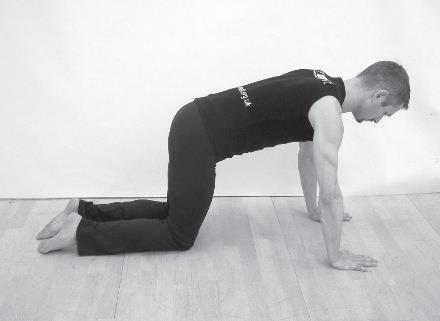
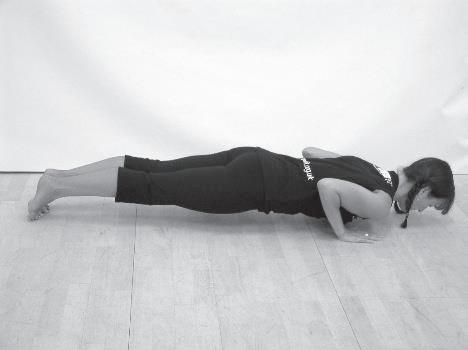
Fig 6.
Press-ups can be incorporated into the sequence here –maybe the 3rd or 4th time through.
Fig 7. Into ‘Cobra’
The body is lowered onto the floor; hands are directly under the shoulders. The upper body lifts up and the chest opens, the elbows should remain slightly bent, the shoulders roll back and down so that they don’t hunch up to the ears. The throat lengthens but the head does not roll back. Take the weight through the hands by spreading the fingers.

Supple Strength | Manual | Version 0821 © YMCAfit 2021 Page | 17
Fig 8. Downward Dog

Draw the chin in, ‘roll over’ the feet lifting the bottom high and pushing the heels down towards the floor. The feet should be hip width apart with the legs as straight as possible without locking out the knees. The crown of the head should be down towards the floor looking in towards the legs. The shoulder blades should be pulled down towards the waist with the arms stretching forward and the sitting bones lifting towards the ceiling. The body should be in an inverted ‘V’ position with the bottom at the highest point.
Fig 9. Forward Bend
Step feet in towards hands; straighten the legs as much as possible without locking out the knees. The crown of the head towards the floor, upper body close to the thighs and sitting bones lifted towards the ceiling.

Fig 10. Extend the Back
Fig 11. Hip Flexion to Standing

Supple Strength | Manual | Version 0821 © YMCAfit 2021 Page | 18
Adapted Salute to the Sun
It is important to start with the ‘modified salute to the sun’ before going into the more challenging version. This enables new class participants and those who are not yet able to try the full version a chance to see and try the easier option. It is also a more gradual warm-up and therefore more appropriate for the warm-up.
Hip Flexion
The hands on the thighs provide additional support for the back. The core muscles must be engaged to keep the back in a safe position; the knees can be bent for comfort. Forward bend. As before. Extend the back. As before.
Step back into Plank/Box (or Tabletop)

Hold plank briefly, drop knees into box position – this can also be used as a press-up option. Sit back onto heels. Stretch arms forward, retract shoulder blades towards the waist, arms active. Into Box. Engage core muscles so the back is in neutral.
Downward Dog. As before. Forward Bend. As before. Extend the back. As before. Hip flexion up to standing. As before.

Supple Strength | Manual | Version 0821 © YMCAfit 2021 Page | 19
Benefits of the Salute to the Sun Sequence
The way we hold and use our body in everyday life often contributes to aches and pains, especially in the back and shoulders. The back is designed to move in many directions. It can:
Flex
Extend
Rotate
Laterally Flex
Salute to the Sun takes the back through flexion and extension in a controlled manner, as well as strengthening the shoulder and core areas. It also stretches the hamstrings and upper body. If press-ups are integrated into the sequence the participants will also be working chest and triceps.
Student Notes:
Supple Strength | Manual | Version 0821 © YMCAfit 2021 Page | 20
Standing Work
Squats into Chair

The squat is strength/endurance work for the quads/hamstrings and entails a set of slow controlled squats at a slow pace. This exercise can be intense for some individuals; participants should be encouraged to stop if they need to.
Option – Arms above the head and the palms pushed together, shoulders away from the ears, retracting the shoulder blades towards the waist.
Do not hold the breath when in the ‘chair’ position.
Supple Strength | Manual | Version 0821 © YMCAfit 2021 Page | 21
Split Lunges into Reciprocal Reach
Split lunges work the quads/hamstrings and glutes. Lunges require balance and strong alignment. The torso should stay in neutral, chest lifted, abdominals engaged, knee and ankle aligned, feet hip width apart. Movement should be up and down not forwards and backwards. With the arms elevated above the head, a greater stretch will be achieved in the upper back.
After the last lunge, slowly shift the body weight forward carefully lifting the foot from the floor and reaching forward with the arms. The aim is to eventually achieve a position where the leg, torso and arms are parallel to the floor. The torso should be stabilised/the back in neutral and the supporting leg strong/straight without the knee locking out. The hips and shoulders should be flat and the neck should be in line with the spine.


Standing Hamstring Stretch
This exercise will achieve balance/strength and both passive and active stretches for the hamstrings.
The abdominal muscles need to contract to keep the back in neutral. The pelvis should be stabilised to hold it in neutral. The supporting leg should be straight and not locked out at the knee. The quads active, shoulder blades together and down, the ribs lifted and open.
The lifted leg should be as straight as possible but options include using a strap or a towel around the foot or if more flexible, grasping hold of the big toe with 2 fingers.
Supple Strength | Manual | Version 0821 © YMCAfit 2021 Page | 22
Tree Pose
For balance and stabilization of the torso.
Standing on one leg, place the ball and heel of one foot into the inner thigh of the other leg. Abs and torso engaged and navel pulling into the spine. Chest lifted and open, stabilise the shoulder blades. Visualise sliding the shoulders down the back; keep them in this position whilst lifting the arms above the head.
Triangle Pose
Designed for balance/strength and stretching of the obliques as well as helping to keep the back mobile and healthy.
Stand with feet approximately twice-hip width apart.
Turn the right foot out to 90º, turn the left foot into about 30º.
Stretch the arms out at shoulder height, keep the hips square to the front, keep the TVA engaged.

Supple Strength | Manual | Version 0821 © YMCAfit 2021 Page | 23
Reach out and then down resting the right hand on the shin, opening out the chest and, if it is comfortable, look up to the top hand.
Try to rotate the top shoulder and the top hip back so that the body is in as straight a line as possible when looking from a side view.
Hold this position for several breaths, release and repeat on the other side.
Warrior Pose
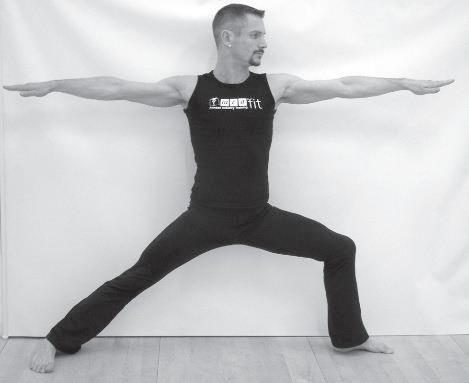
Stand with feet approximately twice-hip width apart.
Turn the right foot out to 90º, turn the left foot in about 30º.
Bend the right knee making sure the knee is directly above the ankle.
Stretch the arms straight out at shoulder height, keep the hips square to the front and the TVA engaged.
Turn the head looking towards the front hand.
Hold this position for several breaths, release and repeat on the other side.
Benefits
Improves postural awareness.
Strengthens legs.
Opens the hip area.
Wide Hip Hinge - Into Back Extension
Legs wide and engage TVA as you flex from the hips. Take hands to the floor or grasp around the calf area. If flexible enough, put palms on the floor lining fingers up with the toes. Lift sitting bones to the ceiling; widen legs further without letting the knees roll in. Take the crown of the head to the ground but be careful not to lock out the knees or round the back. This position will stretch the hamstrings, calf muscles and inner thighs.
Take this into an active back extension to strengthen the spinal extensors and core.
Supple Strength | Manual | Version 0821 © YMCAfit 2021 Page | 24
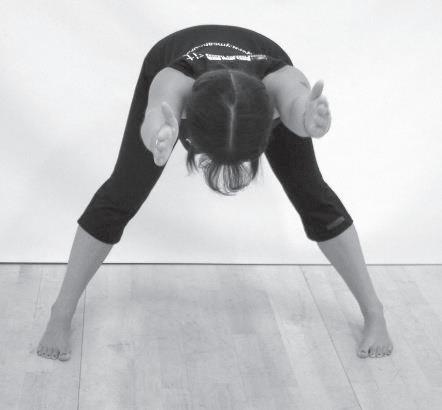

Floor Sequences, Exercises, Postures and Stretches
Once the class has been taken onto the floor, there are a large variety of exercises you can choose from.
A balance of traditional MSE exercises. Stretching and core work, inspired by Pilates and yoga should be incorporated into this section of the class.
Transition onto the floor
After standing stretches and strength work, the downward phase of the ‘salute to the sun’ sequence can work as a smooth transition down to floor work.
Kneeling Reciprocal Reach
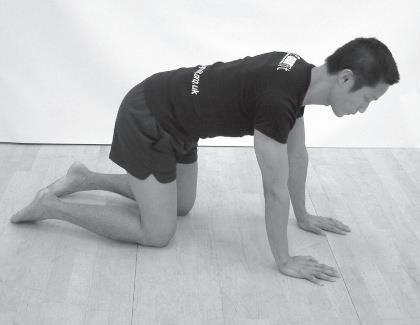
On hands and knees in ‘table top’ position. Shoulders and hips remain square to the front and flat. The T.A. engaged, the core is challenged when the opposite arm and leg extend.
Slowly lift and extend until the arm and leg are parallel to the floor. There should be a straight line from the hand to the shoulder through the back to the hips. The other side of the body should have a straight line from the shoulder through the back and along the leg to the heel.
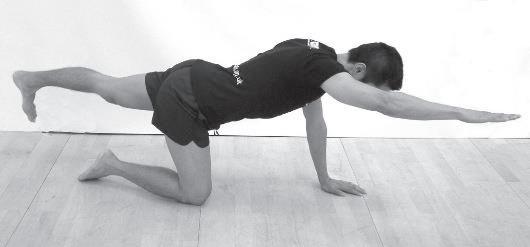
Supple Strength | Manual | Version 0821 © YMCAfit 2021 Page | 25
Alternatives/Adaptations
If it is too difficult to lift the arm and leg together then the limbs can be lifted separately. A more advanced option would be to lift the arms and legs from a straight arm plank position or simply alternate lifting the legs.
Cat/Cow Stretch
Designed to release tension in the back and promote spinal mobility.
Move the back through its range of movement slowly and with control, thinking of moving one vertebra at a time. Keep legs and arms still, just concentrating on moving the spine.


Hip Flexor Stretch
Lift onto the knees; step forward with one leg, knee and ankle in alignment. Slide the leg back whilst the pelvis is in neutral until a stretch is felt in the hip flexor and quadriceps.
Lying Quadriceps Stretch into Bow Pose

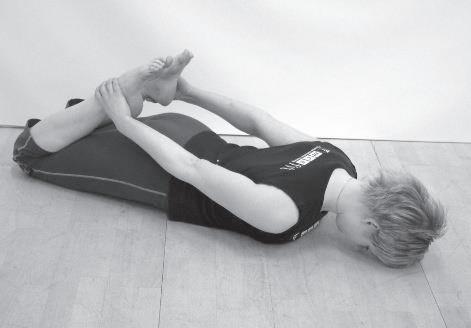
Lie on the stomach, slowly bend the knee and hold by the ankle keeping the spine in neutral. Extend the opposite arm out along the floor and lift the upper body. Look along the arm, keep the neck long and lift the thigh from the floor and try to create space between the heel and the bottom.
Supple Strength | Manual | Version 0821 © YMCAfit 2021 Page | 26
Bow Pose

Grasping hold of both ankles, carefully raise the upper body so the chest is open and the shoulders are back and down, keep the neck long.
This full bow position is not suitable for everyone, those who have knee or back problems need to be careful with this posture and stay with the lying quadriceps stretch.
NOTE: After taking the back into a higher extended position, the back should be taken through an opposite pose to counterbalance it.
Supine Positions
Lying Waist (Oblique) Stretch

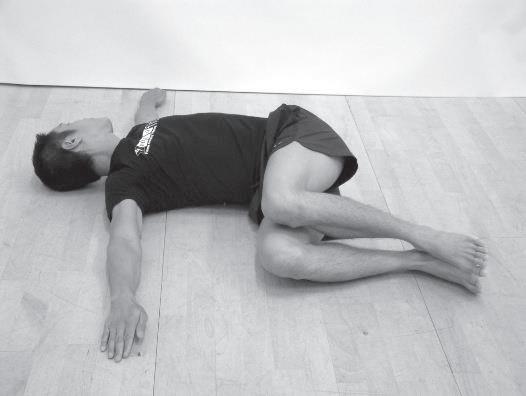
Lie on back with knees bent, feet on the floor and arms outstretched at shoulder height. Let the legs drop over to one side, keeping the shoulder blades on the floor look along the opposite arm.
Stretches the waist and improves spinal mobility.
Supple Strength | Manual | Version 0821 © YMCAfit 2021 Page | 27
Lying Hamstring Stretch
Lie with a neutral spine; try to maintain the position as the leg is raised towards the ceiling. Hold above or below the knee joint.
The knee should be extended with as little bend as possible.
Sit-Ups and Oblique Work

Muscular strength and endurance for the Rectus Abdominis and Oblique muscles.
Make sure TVA is engaged and the exercises are performed slowly. This will make the exercise more intense and allow for more concentration on form.

T Stand

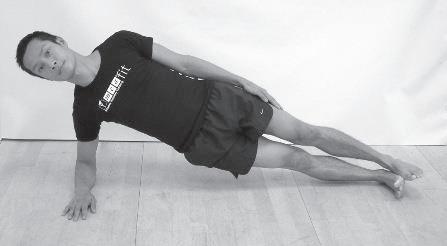
As shown above, an easier option would be to have the elbow underneath the shoulder joint.
Start by lying on the side making sure that the body is in a straight line. Place the hand directly under the shoulder. Push through the hand and straighten the arm, aim to hold a straight line from the crown to the heels.
Advance the exercise by extending the top arm and look at the hand.
Supple Strength | Manual | Version 0821 © YMCAfit 2021 Page | 28


V Sit

Start in a seated position with the knees hip distance apart and the heels close to the bottom. Pull in the abdominal muscles, engage the TA and lean back until the tension is felt in the core. Raise the arms level with the knees. The back needs to remain straight with no curve.
To advance the position the participant can raise their feet off the floor, hold for 10-20 seconds and repeat.
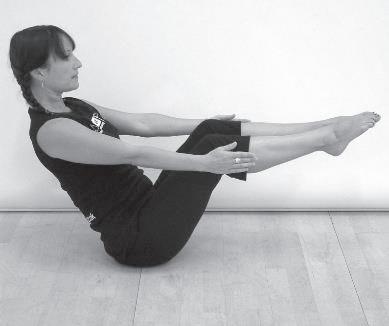

Supple Strength | Manual | Version 0821 © YMCAfit 2021 Page | 29
Seated Hamstring Stretch
Stretch the legs out in front, sit onto the sitting bones lifting up out of the hips, the back is straight, and the pelvis is in neutral. The lower back should feel like it’s working quite hard to hold and stabilise this position. Take the torso towards the thighs; try not to round the back.
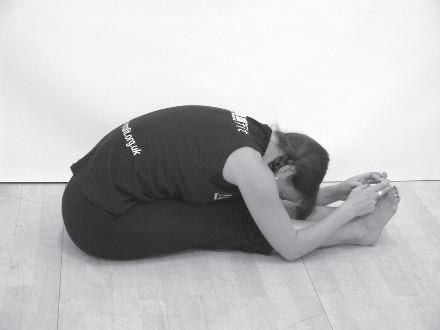
Seated Waist Stretch

Sit with one leg extended along the floor and the other bent up with foot flat on the floor – make sure the back is straight. Rotate the torso around towards the bent knee, place the arm alongside the outside of the leg – use the breathing to help move deeper into the position. Make sure the chest is lifted and open. Avoid rounding of the back.
Bridge
Lie on the floor, with the pelvis lifted and the body weight resting on the shoulder blades, feet hip width apart, ankles under knees –ensure there’s a diagonal straight line from the knee, hip and shoulder. Engage the TA band and contract the gluteus, the spine should be neutral.
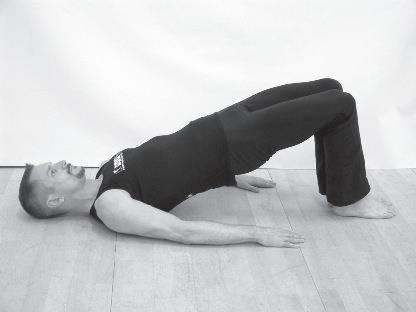
Supple Strength | Manual | Version 0821 © YMCAfit 2021 Page | 30
Long Bridge

Place the hands under the shoulders with the fingers towards the body, point the toes and lift the hips and torso, look at the ceiling, lengthen the throat without dropping the head right back.
Roll Down
Start in an upright position with the knees flexed, engage the core and start to roll down onto the floor rounding the back, rolling down one vertebra at a time
The aim of many exercisers and class participants is the acquisition of a flat stomach. Whilst it is the responsibility of instructors to educate that a combination of healthy eating, cardiovascular (fat burning) and resistance training form a combined approach, core stability and abdominal work can help people to achieve this aim.
Good technique is particularly important when training the abdominal and trunk area. We all know people who do 50 sit-ups a day and still fail to achieve that elusive flat stomach. Understanding how to engage the pelvic floor and T.A. is the first stage of effective abdominal training. Neutral spine and core stability are the foundation of supple strength classes and should be emphasized in all parts of the class.
Supple Strength | Manual | Version 0821 © YMCAfit 2021 Page | 31
Abdominal Lift
Level 1

Level 2


Working with imprinting the spine and extending legs to 90 degrees.
Back Extension


Abdominal and Oblique Exercises
Level 1

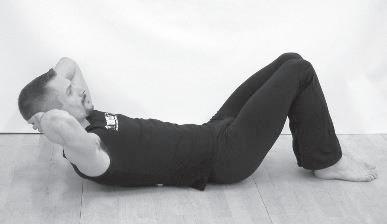

To advance this exercise more experienced participants can work from an imprinted or flat back position. Alternating leg extensions add challenge as the core muscles work harder to stabilise the trunk against the movement of the legs.
Supple Strength | Manual | Version 0821 © YMCAfit 2021 Page | 32
Level 2

Imprint spine with leg extension.
Lie on the back and exhale. Draw up the pelvic floor muscles and engage TA as the spine moves from neutral to imprint. Raise one leg then the other from the floor, keeping knees in line with the hips.
Exhale as the head and shoulders lift diagonally and the leg extends to about a 45-degree angle.
Slowly alternate from side to side exhaling on the diagonal and inhaling as the body comes back to the centre.
Slowly lower the upper body, then each leg and allow the spine to return to neutral.
Benefits
Helps develop flat abdominals.
Works the obliques.
Scissors
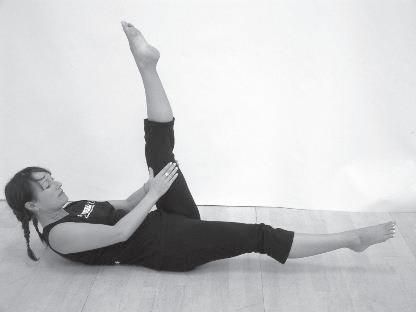
Individuals with good core strength and body awareness will be challenged by this exercise. It works from an imprint or flat back position and is not appropriate for beginners. As above to imprint and engage TA. Straighten legs to the ceiling.
Open the chest and draw shoulder blades towards the waist. Take care not to round the shoulders.
Keep the head and shoulders still while alternating.
Ensure the spine stays in an imprinted position.
Exhale with each repetition.
Draw the knees back to the start position, lower the head and shoulders, then one leg at a time to the floor.
Allow the spine to return to neutral.
Supple Strength | Manual | Version 0821 © YMCAfit 2021 Page | 33
Benefits
Develop flat abdominal muscles and core.
Roll Up
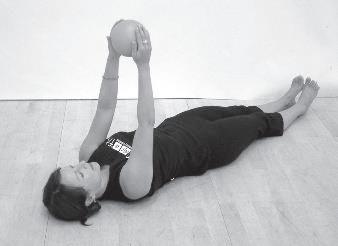
Lie on the back with feet and legs together and spine in neutral.
Place arms on the floor behind the head and hands shoulder width apart.
Avoid rounding the shoulders by keeping a space between the ears and the shoulders. Feel the connection between the shoulder blades and the ribs.
Inhale, then exhale as the arms slowly lift from the floor until the hands are in line with the shoulders.
Imagine peeling the spine from the floor, one vertebra at a time until seated.
Inhale, then exhale as the movement is reversed lowering one vertebra at a time.
Concentrate on keeping the movement slow and controlled. Flatten the rectus abdominis and feel the connection between the lower ribs and the hip bone as well as those between both sides of the rib cage.
Benefits
Develops flat abdominals and a strong core.
Builds strength, mobility and control in the spinal extensors and stabilisers.
Supple Strength | Manual | Version 0821 © YMCAfit 2021 Page | 34
Supple Strength | Manual | Version 0821 © YMCAfit 2021 Page | 35



